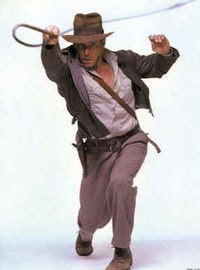Bullwhip
A bullwhip is a single-tailed whip, usually made of braided leather, which was originally used as a farmer's tool for working with livestock.
History

Bullwhips were traditionally used as a farm tool especially popular with cattle drivers. A bullwhip's length, flexibility and tapered design allows it to be cast by an expert in such a manner that the very end travels fast enough to break the sound barrier. There are many ways to crack a bullwhip but they all involve the conservation of energy. In the forward crack, the handle of the whip is cast forward, propagating a loop (or hairpin-like curve) forward down the length of the whip. As the loop propagates down the whip, the speed of the loop increases as the thickness and weight of the whip decreases. When cracked properly, the very end of the whip (the "cracker" or "popper") goes supersonic and a minor compression wave (sonic boom) is created. This sounds something like a small thunderclap. This loud noise was used to train cattle and keep them from straying, as well as to slay predators. While a bullwhip can be used for protection against stray cattle, it would be very rare for the herdsmen to actually strike the animal due to the damage that can be inflicted. As the rural cultures have shrunk over the last hundred years, fewer and fewer whipmakers maintained the art of Bullwhip construction.
In recent American culture the bullwhip was re-popularized when featured in Raiders of the Lost Ark and its sequels. The hero, archeologist-adventurer Indiana Jones, uses it as a means of controlling his enemy's position while maneuvering for advantage or to snare handheld objects and pull them away from his enemies, while the same technique allows him to use the whip as a swing line to traverse gaps. Zorro had done so before.
Show cowboys and circus artist will often do trick-cracking and target work in their performances. In the past bullwhips were also used as a whip for physical punishment, though due to the higher speed the damage inflicted from bullwhip flogging can be more severe than that of a cat o' nine tails. Bullwhips are occasionally associated with BDSM [1]
Anatomy of the Bullwhip
A bullwhip consists of a handle section, a thong, a fall, and a cracker.
The main portion of the bullwhip's length is made up of a braided body or thong. Made of many strips of leather, the number of braids or plaits is an important factor in the construction of the whip. Often times the thong is multilayered having a "belly" in the center. Unlike in the Australian stock whip, the thong connects in line with handle (rather than with a joint), or even engulfs the handle entirely.
The handle is usually short, being between 8 and 12 inches long. While mass produced low quality whips generally have an exposed wooden grip, it is very common for high quality whips to have an intricately braided leather covered handle. The handle also usually contains a butt foundation, which is held in the palm of the hand when cracking, and can have a wrist loop, used for hanging the whip at the end of the day, not for putting around the wrist during use.
Bullwhips are measured from the butt of the handle to the end of the plaiting of the thong. The thong typically terminates at a fall hitch - a series of half hitches that neatly tie the replaceable fall (or tail) to the whip. Whips range in length from 3ft to very long bullwhips of 20ft with some examples being even longer.
A fall is a single piece of leather typically slightly thicker than the braids used in the thong, and between 10 and 30 inches in length. During trick shots, or target work the fall is usually the portion of the whip used to cut, strike, or tie the target. The fall can also be a continuation of one of the strands used in plating the overlay. Further, the fall can be an extension of the core of the whip, with the strands from the overlay tied off, and the core continuing on as the fall.
Tied to the end of the flexible fall, is an even more flexible piece of string or nylon cord or wire called the cracker or the popper. The cracker is the portion of the whip that makes the loud noice known as the sonic boom. This can cause severe fraying and punishment to the tip, and well used whips frequently require new crackers.
Bullwhips come in many different weights, materials, and designs. Some light whips use shot loading or lead weighting to affect their balance. Though usually made of strips of leather, nylon whips have become popular in wet climates where leather is difficult to maintain. In America, cowhide and oxhide leathers are most common for construction with kangaroo also being used; these first two tend to be quite thick and sturdy and are good for harsh conditions. In Australia, where whipmaking still thrives, kangaroo leather is by far the most popular, being very pliable. Most whip-crackers doing target work prefer a whip made of kangaroo skin. Kangaroo hide is preferable is because it is many times stronger than cow hide and can be cut in to fine, strong laces. Whip making is still alive and well in the United States which has a number of whip makers including the maker of the whips featured in the Indiana Jones movies, David Morgan.
References and further reading
- Andrew Conway, The New Bullwhip Book, Paladin Press, 2005. ISBN 1-55950-244-2.
- David Morgan, Whips and Whipmaking, Cornell Maritime Press; 2nd edition (March 2004). ISBN 0-87033-557-X
- Ron Edwards, How to Make Whips, Cornell Maritime Press, 1999. ISBN 0-87033-513-8.